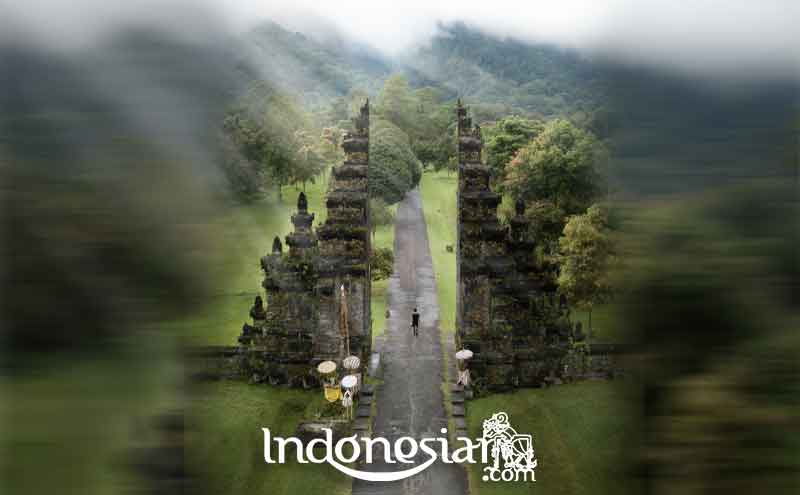Indonesia is a country with the largest Muslim religion in the world. In every region in Indonesia, of course, mosques are often found. Although it is known as a Muslim majority country, Indonesia has several areas whose population is predominantly religious other than Islam, namely the province of Bali.
Almost all Indonesians already know that the majority of the population or people of Bali are Hindus, then what is the history, story or origin of the entry of this religion to the island of Bali.
There are a number of historical evidences that describe the historical story of Hinduism in Bali including the development of Hinduism to date, for this reason we briefly describe how the history of Hinduism arrived in Bali, of course we take it from a number of sources that can complement the article. this.
As is known, the holy place of Hinduism is a temple and almost everyone who is Hindu has a temple in their yard including businesses, schools and offices, so it is not surprising that Bali is also known as the island of Seribu Pura.
Bali itself is known as a world tourist destination. There are so many foreign influences coming to this island, however, with the fortification of faith which is also with Hindu religious teachings, it is able to filter out these foreign cultures properly.
The history of Hindu development until now has developed quite dynamically and universally without reducing the meaning of a belief in God, Hindus in Bali themselves live in harmony with other religions. respect.
History of the existence of Hinduism in Bali
Before the entry of Hinduism to Bali, Balinese people naturally had their own beliefs. The history or origin of Hinduism in Bali, of course, began with the entry of Hinduism into the archipelago, where Hinduism first came from India, in the 15th century BC, they entered Indonesia through South China in two different directions, that is, from the western direction it enters through Indo China, Malaya, Siam and spreads in Kalimantan, Sumatra and Java, while from the north via Japan, the Philippines, Taiwan and then spreads in Eastern Sulawesi and Irian.
Then the history or the origin of the entry of Hinduism to Bali, is closely related to the arrival of the Majapahit people who already have Hinduism and understanding. Balinese society prior to the arrival of the Majapahit people consisted of various faiths and were divided into various sects, long before the arrival of Hinduism from Java or Hindu Majapahit to Bali, the history of the entry and development of Hinduism in Bali after the prehistoric era of Bali where people did not know writing, along over time the influence of Hinduism began to enter at the time of the arrival of Majapahit under the leadership of Gajah Mada.
Gajah Mada was a governor from the Majapahit kingdom who had Hindu-Buddhist understanding. The history and development of Hinduism in Bali is inseparable from Hinduism in Java and India and in its history it has experienced a fusion with Buddhism. This resulted in Hinduism in Bali in practice being different from Hinduism in India. Hinduism that develops in Bali follows local culture, traditions and wisdom, so that in daily implementation, or in the implementation of religious and traditional ceremonies, it may be different when compared to the contents of the Hindu holy book, the Veda.
Also found was an inscription containing the history of Hinduism in Bali, namely in Gianyar, precisely in the village of Pejeng which used Sanskrit. In this case, the history and development of Hinduism in Bali is thought to have been influenced by Hinduism from Central Java and East Java which is thought to have entered Bali before the 8th century AD. The inscription is inscribed with the word “sivas siddhanata”. Thus, the 8th century Siwa Siddhanta has developed in Bali. The development of religious teachings adhered to by the king and the people of course went through a long process, so that the Hindu Siddhanta sect had entered slowly before the 2nd to 8th centuries AD.
In Bali itself during the reign of Ancient Mataram (between 600-1000 AD) there was already a kingdom based in Bedulu with a king descended from Warmadewa, there is a possibility that this kingdom at that time got the influence of Hindu traders or maybe even from the influence of the kingdom of Mataram. Then at the end of the 10th century in Bali ruled by a king named Marakata who was the younger brother of Airlangga (Erlangga) both were children of king Udayana who was the king of the Bedulu Kingdom, Erlangga himself ruled on the island of Java.
The history of the Balinese occupation was carried out by the Singasari kingdom, namely Kartanegara, Bali was conquered in 1284, but did not last long because in 1383 the Majapahit kingdom sent its troops with the leader of the ruler Gajah Mada to invade Bali. Singasari was conquered and the kingdom was taken over by Majapahit, and the ruler of Gajah Mada brought the nobles from Majapahit to rule Bali, and established a kingdom with his capital called Samprangan, then the kingdom was moved to Klungkung with a king called Dewa Agung.
At this time the influence of Majapahit was very strong in Bali, beginning with the nobility, including religious life, although there are a number of isolated places still remain strong with their beliefs like the Balinese Aga who refused with foreign cultures entering their territory, but they were not . Javanese Hindu culture has mixed with Balinese culture so that there is cultural acculturation and it is difficult to separate, the mixture is so strong that it forms a new religion, which the Balinese know as Tirta religion and later referred to as Hindu Dharma.
From the history of the Hindu religion above, it will clearly be different from the Hindu religion in India and in Java, due to the unification of local culture with the influential Hindu influence, will appear different procedures in believing their beliefs. Come on, get interesting information from Indonesiar.com and share this article to add insight to many people.
































